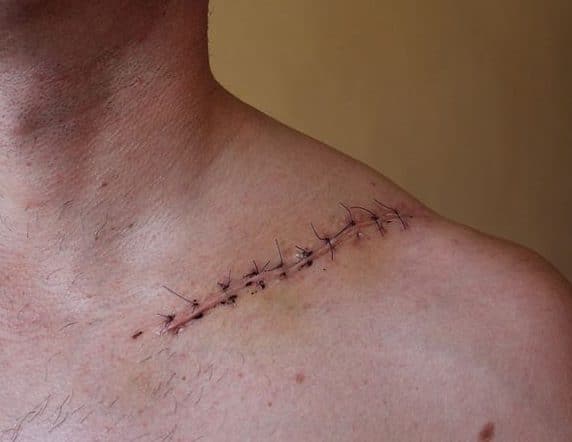The basic principles for the management of a wound or laceration are:
- Haemostasis
- Cleaning the wound
- Analgesia
- Skin closure
- Dressing and follow-up advice
These principles can be applied to any simple wound, yet always involve your senior colleagues for advice and input as necessary.
Always remember your own personal protection when assessing a wound, including gloves, apron or gown, and goggles/visors
Haemostasis
Haemostasis is the process that causes bleeding to stop. In most wounds, haemostasis will be spontaneous.
In cases of significant injury or laceration of vessels, steps may need to be taken to reduce bleeding and aid haemostasis. These include pressure, elevation, tourniquet, or suturing.
Cleaning the Wound
Wound cleaning is important for reducing infection and promoting healing. There are five aspects of wound cleaning:
- Disinfect the skin around the wound with antiseptic
- Avoid getting alcohol or detergents inside the wound
- Decontaminate the wound by manually removing any foreign bodies
- Debride any devitalised tissue where possible
- Irrigate the wound with saline
- If there is no obvious contamination present, low pressure irrigation is sufficient* (pouring normal saline from a sterile container carefully into the wound)
- Antibiotics for high-risk wounds or signs of infection (follow local antibiotic guidelines)
- Risk factors for wound infection include foreign body present or heavily soiled wounds, bites (including human), puncture wounds, and open fractures
*If the wound is clearly contaminated, it must be irrigated at high pressure to remove any visible debris present
Analgesia
Analgesia will allow for a humane and easier closure of the wound. Infiltration with a local anaesthetic is the most common form of analgesia used, with regular systemic analgesia (such as paracetamol) used as an adjunct.
The maximum level of lidocaine is 3mg/kg and the addition of adrenaline allows for up to 7mg/kg (a 1% solution equates to 10mg/ml). Remember to not use adrenaline with local anaesthetic if administering in or near appendages (e.g. a finger)
Skin Closure
The aid wound healing, the edges of the wound can be manually opposed. There are four main methods of doing so:
- Skin adhesive strips (e.g. Steri-StripsTM) are suitable if no risk factors for infection are present
- Tissue adhesive glue (e.g. Indermil®) can be used for small lacerations with easily opposable edges (a popular choice in paediatrics)
- Sutures are typically used for any laceration greater than 5cm, deep dermal wounds, or in locations that are prone to flexion, tension, or wetting
- Staples can be used for some scalp wounds

Figure 1 – Suture wound closure, following clavicular surgery
Dressing the Wound and Follow-Up
Correct dressing of the wound will reduce infection and contamination.
When applying a wound dressing to a non-infected laceration, the first layer should be non-adherent (such as a saline-soaked gauze), followed by an absorbent material to attract any wound exudate, and finally soft gauze tape to secure the dressing in place.
Tetanus prophylaxis is required for any individual not up to date with (or unsure of) their tetanus immunisation status.
Following initial wound management, advise patients to:
- Seek medical attention for any signs of infection
- Take simple analgesia (e.g. paracetamol)
- Keep the wound dry as much as possible, even if wearing a waterproof dressing
Any sutures or adhesive strips should be removed 10-14 days after initial would closure (or 3-5 days if on the head); tissue adhesive glue will naturally slough off after 1-2 weeks. Remove dressings at the same time as the sutures or adhesive strips.
Key Points
- Clean the wound thoroughly, starting antibiotics and referring for debridement as necessary
- Ensure adequate analgesia is provided
- Choice of skin closure technique depends on the wound
- Ensure the wound is appropriately dressed
